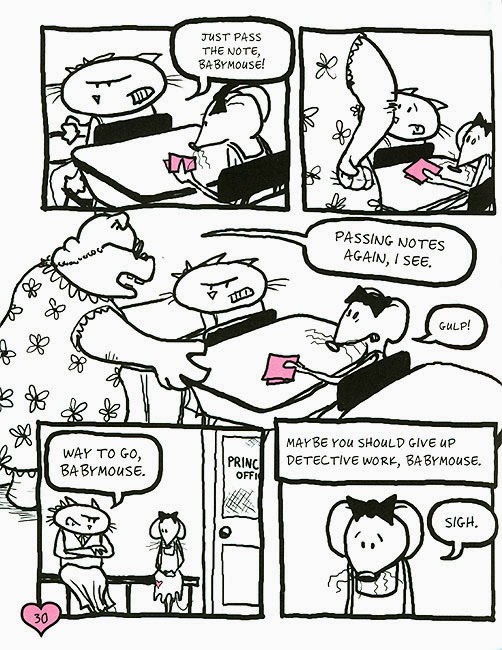Introducing…. BABYMOUSE: QUEEN OF THE WORLD! Ok, not really.
But she sure wishes! Babymouse:
Queen of the World is an entertaining graphic novel by siblings Jennifer L. Holm and
Matthew Holm. It is the first of the series and was published in 2005.
Babymouse is about a creative, sassy girl mouse
enduring the typical issues of adolescence. She wants so badly to fit in with
her peers, particularly the most popular girl named Felicia Furrypaws.
Babymouse has a childhood best friend named Wilson the weasel and they have a
lot in common. One day, Babymouse discovers that Felicia is having a sleepover
and it seems that most girls in her grade are invited. except Babymouse! She is
obviously devastated and has multiple (and hilarious) daydream adventures about
the issue. The opportunity arises for Babymouse to get invited to Felicia’s
party when she is asked to give Felicia her book report that is due that day in
return for an invite. Babymouse quickly jumps at the chance and doesn’t look
back which in turn makes her forget that she already had plans that same
evening with Wilson. Babymouse remembered her plans with Wilson later on but
decided to go on with her popular girl sleepover anyway. However, at the
sleepover Babymouse discovers that she is not interested in the same things as
these popular girls and doesn’t have fun. In the end, Babymouse heads over to
Wilson’s house to watch a movie like originally planned!
Finally, a graphic novel series for girls! This text is full of
excitement and hilarity. It is sure to be a hit among young girls due to the
pink theme, hearts, and relatable adolescent storyline. The illustrations are
simple but with the right amount of details. I especially enjoyed all of the
creative daydreams that Babymouse had in the text. They regularly included her
as a hero protagonist and were a riot! These
daydreams were illustrated with a predominant black background which made them
easy to differentiate from the actual story line. However, I do wish there was a bit more color instead of just black, white, and pink but that may just be the artist in me. As a teacher, I believe this series will be a
big hit with my second graders, particularly the girls. I am going to conduct a
book talk with them about this book on Monday and gauge their responses. I am
always trying to expose them to new genres and I have not seen my students read this series yet.
My favorite part of this
graphic novel other than Babymouse’s hilarious and sassy personality is the
message behind it. The message in this book is clear: stay true to who you are! Trying to
be like everyone else will not make for a happy life. Trust your instincts,
love your friends, and celebrate yourself!
If you would like to check out this book for FREE at your local library, go ahead and click the "Image Source and Find a Copy!" link at the bottom of this post.
Image Source and Find a Copy!
Image 2 Source





.JPG)

.JPG)
